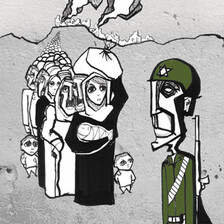The Guardian Nazareth, the Galilee 12 January 2003
It is a reflex question for Palestinians, always posed early in the Arab greeting ritual, to ask a stranger, even another Palestinian, “Where are you from?” before enquiring: “Where do you live?” Few Palestinians live where they feel they belong.
Ziyad Awasie is no exception. He, like some 5 million other Palestinians, is a refugee, though not in the camps of Lebanon or Syria, or under military occupation in the West Bank or Gaza, or for that matter in the more pampered exile of Europe and the US.
The 28-year-old physiotherapist is one of the million Palestinians who live today as citizens of Israel. To outsiders it is an assumption easily made that these Palestinians remained on their land - even if up to 800,000 others fled to neighbouring Arab states during the war that founded Israel in 1948. The assumption, however, is wrong.
Although Awasie was born and raised in Nazareth, in Galilee, it is not where he is from. He and his two younger brothers, Amjad and Mohammed, consider themselves inhabitants of the village of Saffuriya, one of the biggest villages in Palestine before the nakba (catastrophe) of 1948.
“We have ties to tens of thousands of other Saffuriyans now scattered across the globe, including in Sabra and Shatila,” he says, referring to the two Lebanese camps where more than 1,000 Palestinians were massacred in 1982 under the watch of the Israeli army.
Israel classifies the Awasies as internal refugees, along with 250,000 other Israeli Arabs, one in four of the country’s Arab population. They are the descendants of families from some 400 villages destroyed by Jewish forces during and after the 1948 war. Their families evaded capture by hiding in the hills and other villages or slipped back across the border when the fighting died down.
None has ever been allowed to return home. They live in Israel as “present absentees”: present in Israel but absent from their property. Legislation passed decades ago ensures they will never be able to lay claim to their old lands.
For Awasie’s grandparents, who fled Saffuriya along with 6,000 other Muslim villagers in 1948, sanctuary was eventually found in the town of Nazareth, two miles away. Many Saffuriyans assumed, rightly, that Israel would leave the small Christian town alone rather than risk the wrath of the international community.
The result, 54 years later, is that Nazareth is now two-thirds Muslim. The families from Saffuriya even have their own neighbourhood, Suffafra, on a hill overlooking the fields their ancestors once planted with olive and citrus groves.
The villagers, like Palestinians across Israel, have been struggling for years to be allowed to re-establish a connection to their lands. Recently they won a legal battle to clear a path through the thick overgrowth of cactuses smothering the main cemetery to tend the graves.
But Awasie says he is not interested only in resurrecting ghosts. Each autumn he and others stage a festival in the fields near the old village to commemorate what Saffuriya once was and to acknowledge how far it still shapes their identity. Plays are staged, debates held and artefacts they have recovered from the site are shown to a new generation.
This year Awasie and his friends made a short film about elderly Saffuriyans returning to the site of their homes. It was not an easy project. The destroyed houses are fenced off as a military area. The old sandstone rubble can still be glimpsed through fir trees planted to conceal the evidence of a distant crime.
Their presence filming was not welcomed by the site’s new inhabitants: a few dozen Jewish families from the farming cooperative on land now renamed Tzipori. When they realised who the group was, Awasie says, some threatened to call the police. “We are happy to share these lands but it seems the families of Tzipori don’t want to be reminded that the true owners live just a short distance away.”




